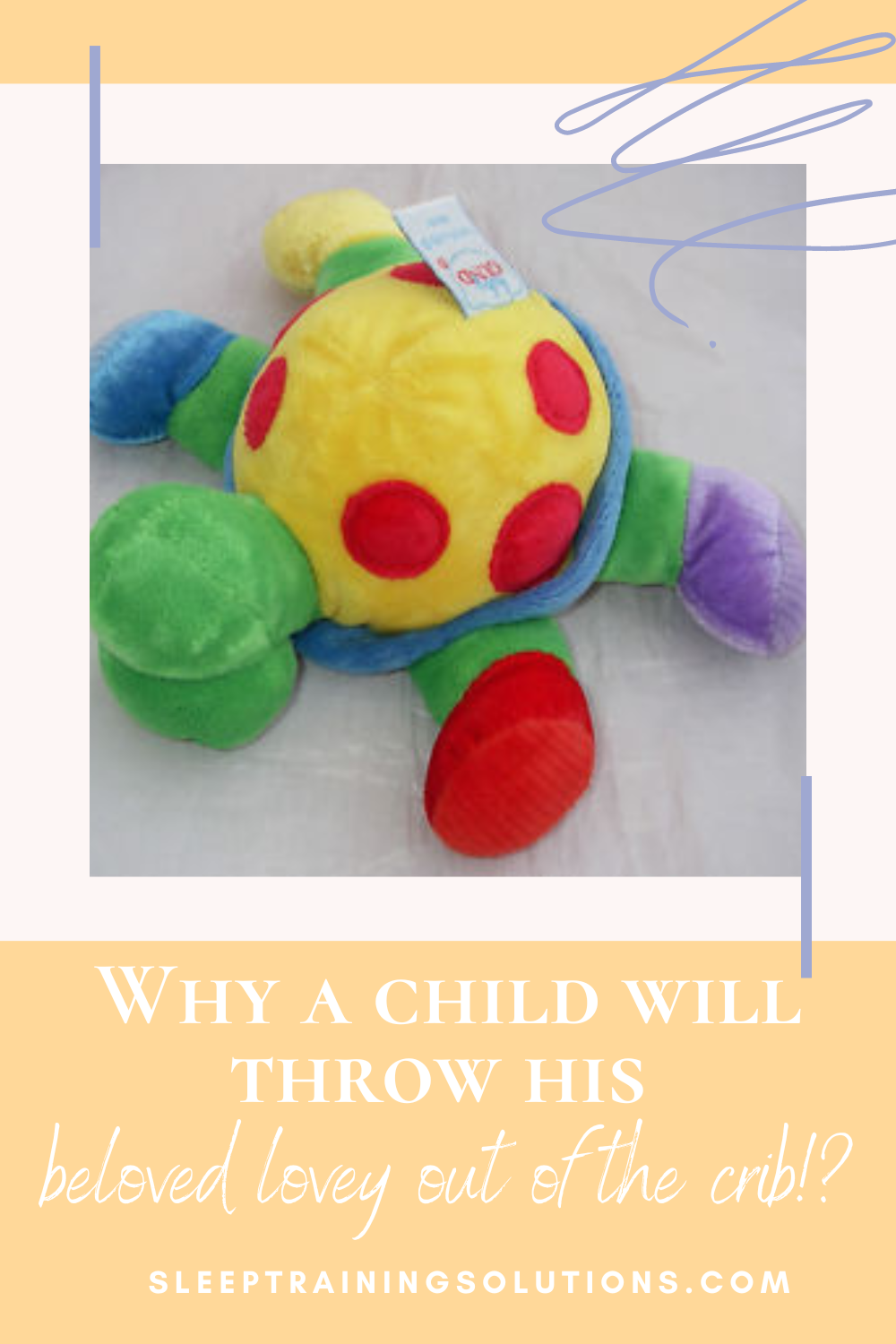Why does a child throw his beloved lovey out of the crib!?
What to do when your child throws her lovey out of the crib
[Updated 7/27/24]
If you’ve found yourself on a nightly scavenger hunt for a tossed lovey or had your child throw it out 52 times before nap time, you’re not alone. Many toddlers learn that flinging their cherished comfort object—a teddy bear, blanket, or other lovey—can prompt a super fun game of fetch with their parents! In this blog post we’ll discuss why this is happen and how to handle this very common bedtime behavior effectively!
Frustrating but normal
First, I want to tell you that what your child is doing is COMPLETELY normal! Frustrating, but normal.
I remember this game all too well. My son would throw his favorite lovey (a turtle, aptly named Turtle) out of the crib repeatedly as soon as I put him into his crib for bedtime (or naptime).
This was pre-sleep training (and before I became a sleep consultant!), so I didn’t have the knowledge back then to deal with this situation properly.
I would go in and reason with him as a 12 month old (that in itself is a crazy idea!) and have lengthy conversations about why he shouldn’t be doing that – not wanting to hurt turtle, he needs to go to sleep, etc.
Since I’ve got experience now as a sleep consultant, I have a better approach on HOW to curb this behavior.
What is a lovey?
A lovey, often referred to as a comfort object or transitional object, is an item that provides comfort to children, particularly during their early years.
It could be a stuffed animal, a small blanket, one of mom’s t-shirts…I’ve even seen a few kids attach to a regular white burp cloth!
Here are some of my favorites:
Pro Goleem Puppy Head and Security Blanket
ZIGJOY Baby Security Blanket Muslin Baby Lovey
Saranoni Luxury Baby Blanket Mini
These are NOT good loveys
Items that do NOT make good loveys include:
loveys made with crinkly or noisy fabric
loveys with a pacifier attached
anything hard that could be uncomfortable if they roll over on it
one that makes noise or lights up
anything too large or bulky that a child could eventually leverage as a step to climb out of the crib
Optimal timing to introduce a lovey
The American Academy of Pediatrics (AAP) advises that during the first year of life, babies should sleep in a crib without any additional objects, including loveys.
This precaution is to avoid potential suffocation risks, especially when they’re babies and do not have the fine motor skills yet to be able to move something away from their face.
When you start to introduce the lovey, hold it on your lap for the bedtime and nap time routines to help your child start associating it with comfort and being cozy.
Lovey “maintenance”
I always recommend getting 2-3 of the EXACT same loveys once you learn which one your child is attaching to.
Keep the spares in the closet, hidden away, until it’s time to wash the crib sheets and then wash the current lovey with the crib sheets and put that one back in the closet rotation and pull out a spare. Washing the lovey in rotation will help them all look “loved” equally.
I also suggest keeping the lovey in the crib at all times so it stays clean, you don’t worry about losing it and it can be very motivating when the child hasn’t see it all day.
Why do toddlers throw their loveys
Understanding the reasons behind why toddlers throw their loveys can be helpful in addressing and managing this behavior effectively. Here are some key motivations that often drive your little one to toss the lovey out of the crib:
Attention-Seeking
Toddlers thrive on attention, and tossing their lovey out of the crib is a clever tactic to get it! Throwing the lovey out of the crib, they’re getting:
Instant feedback: Each time you pick up the lovey, your child learns their actions prompt a response. This can become a game where they feel in control.
Connection they crave: Sometimes, this behavior reflects a desire for more interaction. Even a brief moment of eye contact can be satisfying.
What you can do:
Minimize attention: When retrieving the lovey, keep your actions calm and quiet. Avoid eye contact and limit conversation to prevent reinforcing the behavior.
Attention outside the bedroom: Increase quality time during the day. Engage in activities like reading, playing, or taking walks, which can fulfill their need for attention and reduce bedtime antics. One on one time when you aren’t constantly checking your phone is priceless!
Consistent routines: Establish a predictable bedtime routine that includes plenty of attention and cuddles, so your child feels secure before sleep.
Positive reinforcement: Praise your child for staying in bed and keeping the lovey in the crib. This encouragement can motivate them to maintain good behavior.
Exploring Cause and Effect
For toddlers, throwing their lovey and observing the outcome is an exciting experiment in cause and effect. This behavior is more than just a playful game; it's an important developmental milestone. Understanding object permanence is a big milestone for babies and learning that a toy is still somewhere, even when they drop it, is pretty cool! Here’s how you can understand and manage this behavior while fostering their learning:
Learning in action
Developmental milestones: Throwing a lovey to see what happens is part of your child’s understanding of cause and effect. It helps them grasp that their actions can trigger specific reactions in their environment. This is a key aspect of cognitive development. It’s a new skill. Between 7-9 months, fine motor skills are developing and babies are able to pick up a medium-sized object and drop it. By 12 months, babies are intentionally doing this to get a reaction! (To see milestones by age, click here.) Also, the current Academy of Pediatrics recommendation is that children should not sleep with a lovey before their first birthday.
Reinforce learning: When they toss their lovey, let them know you see they're figuring out how their actions lead to different results. It shows them that they’re learning from their behavior, even if it’s causing a bit of chaos.
Curiosity at play
Natural experimenters: Toddlers are naturally curious and love exploring their world. When they toss their lovey, they're basically experimenting to see what happens next. It's their way of figuring out how things work and satisfying their urge to understand their surroundings.
Exploration opportunities: Give your child chances to explore cause and effect in a safe way during the day. For instance, let them play with toys that pop up, roll, or make noise when they interact with them. These kinds of toys show them how their actions lead to different results and satisfy their curiosity about how things work..
Guiding their understanding
Daytime activities: During the day, try playing games with your child that focus on cause and effect. For example, you could stack and knock over blocks or use toys that do something fun when they press a button. It’s a great way for them to learn how their actions create different outcomes!
Interactive learning: Make the most of everyday moments to show cause and effect. For instance, you can point out how turning the faucet makes water come out or how pressing a lever makes a toy move. Just explain what’s happening in simple terms to help your child understand how their actions lead to different results.
Consistent responses
Predictability is key: When your child throws their lovey, it's key to handle it the same way each time. Consistency helps them figure out that tossing the lovey will always have a clear result. For example, if you always give it back right away, they might think it's a game. Instead, try sticking to a routine, like only returning the lovey once they're asleep. This way, they'll start to get that there are clear boundaries around the behavior.
Setting boundaries: Make sure you’re clear and consistent with how you respond to their behavior. For instance, if you decide to use a balanced approach, where you explain that throwing the lovey repeatedly means it will stay out until morning, be sure to stick to that every time. Keeping this consistency helps them understand that their actions have real consequences and teaches them about boundaries and what to expect.
Positive reinforcement
Celebrate understanding: When your child gets the hang of cause and effect through their play, like with toys that pop up or move, make sure to give them some praise and encouragement. It’s a great way to show them they're on the right track and boost their confidence as they learn.
Encourage curiosity: Keep nurturing their curiosity by giving them lots of age-appropriate toys and activities where they can experiment and learn. It’s a fun way to support their exploration and help their brain grow!
Developing Independence
Throwing a lovey is not just a playful act; it's a small yet significant way for toddlers to exercise their growing sense of independence and control. They want more control. Let’s face it, you pretty much make all the decisions for your child–when to get in the crib, what to wear, what to eat, you probably even suggest the books to read and the toys to play with…It’s no wonder he or she wants to have more of a say! By throwing the lovey out of the crib, your toddler is saying, “I’m telling YOU what to do for a change!” Understanding this can help you support their development while managing the behavior effectively.
Testing boundaries
Exploration of limits: Toddlers are in that stage where they’re always testing boundaries. They’re super curious about what they can control and how their actions impact the world around them. Throwing a lovey is just one of the ways they’re figuring out these limits.
Behavior as experimentation: When toddlers toss their lovey, they’re basically experimenting to see how rules and consequences work. They might be testing to see how you’ll react or if they can change things with their actions. Understanding this can help you respond in a way that supports their learning without encouraging disruptive behavior.
Empowerment
Sense of agency: When toddlers throw their lovey, they're really just testing their power to make decisions, even if it's something as small as where their lovey lands. It might seem like a small thing, but it gives them a little boost of control and empowerment.
Building confidence: Letting them make small choices during the day, like picking out their clothes or choosing between two bedtime stories, helps them feel more in control. These little decisions give them a sense of agency and can actually help cut down on the need to assert control in other ways, like throwing their lovey.
Supporting independence
Encourage decision-making: Encourage your toddler’s independence by letting them make choices in their daily routine. Whether it’s picking out pajamas, choosing between two bedtime stories, or selecting a toy to play with, giving them these small decisions helps them feel more empowered and involved. It’s a great way to show them they’re respected and capable.
Structured choices: Give your toddler choices that are simple and age-appropriate. For example, you could ask, “Do you want to wear the red pajamas or the blue ones today?” This way, they get to feel in control by making the final decision, but you’re given them limited suitable options to choose from.
Setting limits
Consistent boundaries: At bedtime, it’s key to set boundaries gently but clearly. If your child throws their lovey, calmly let them know what will happen next. You could say something like, “You need to hug your lovey and lie down now because I won’t be coming back to get it.” This way, they understand that their actions have consequences and that there are limits to what they can control.
Clear communication: When setting limits, keep it simple and clear. Kids need to know not just what’s expected, but also why it matters. By calmly explaining what will happen if they don’t follow the rules, you give them a clear sense of what’s okay and what’s not. This helps them feel more secure and less likely to push boundaries in ways that lead to trouble.
Positive reinforcement: When your child follows the rules and handles their lovey well, give them a high five or some praise when they wake up! It’s a great way to encourage them to keep up the good behavior and helps them understand what’s expected. Positive reinforcement shows them that good choices are noticed and appreciated.
Balancing independence with security
Provide safe spaces: Give your child chances to explore their independence in a safe and controlled way - outside of sleep situations. Set up a special play area where they can make choices and experiment, knowing that it won’t affect anyone else. This helps them feel empowered while keeping things manageable and secure.
Reassurance and support: Make sure your child feels secure while they're testing their boundaries. Stick to consistent routines and comforting rituals to show them that even though they're learning and growing, they're still supported and loved. This helps them explore their independence without feeling unsettled.
Effective Strategies for Handling Lovey Tossing
Immediate response
When your child throws their lovey out of the crib, it’s important to address the situation calmly and consistently. Here’s how to handle it effectively:
Stay calm: Approach the crib without showing frustration or annoyance. (Easier said than done!) Your calm demeanor helps avoid adding extra stimulation to the situation.
Minimal interaction: Return the lovey quietly without engaging in conversation or making eye contact. This minimizes the chance of turning the act into a game that seeks more interaction. Go in quick, pick it out, lay it on the crib mattress (don’t toss back in because then it looks like you’re starting to play the tossing game too!) and leave without any talking.
Consistency is key: Ensure that every time the lovey is thrown out, you follow the same procedure. Consistency helps your child understand the expected behavior and the boundaries.
Wait-to-return method
If the tossing continues despite your initial response, the wait-and-return method can be a useful strategy. Because you aren’t going back in to get the lovey, it’s can be harder in the moment, but can improve the lovey tossing issue faster:
Wait until asleep: Allow your child to fall asleep before retrieving the lovey. This approach prevents the behavior from becoming a game that prolongs the process.
Avoid reinforcement: By waiting until your child is asleep, you reduce the likelihood of reinforcing the tossing behavior with your attention.
Teach patience: Over time, this method helps your child learn that repeated tossing does not result in immediate rewards (aka your attention).
Balanced approach
Combining elements of both the immediate response and wait-and-return methods can be effective for older toddlers:
First toss response: Retrieve the lovey immediately the first time it is thrown. Calmly return it while explaining, “I’ll bring it back this time, but if you throw it again, I’m not getting it for you again.”
Set clear expectations: Use clear and simple language to set expectations. This helps your child understand the consequences of their actions.
Follow through: If the lovey is thrown again after your explanation, wait until your child is asleep before returning it. This reinforces the idea that throwing the lovey results in losing it for the rest of the night.
My personal preference is the immediate response method because I see it works best for the majority of kids. You quietly and calmly go into your child’s room and without eye contact or conversation, place the lovey on the crib mattress (without making physical contact with your child) and leave the room.
If you end up doing it more than 3-4 times (or fill in your threshold), you give a warning that you won’t be coming back in, so they need to lie down with their lovey. If they throw it out again, you don’t go in.
You may have to do it several times a night (or for a nap), and maybe for a few days in a row, but the no-nonsense approach will quickly make this game boring for your child!
Why does my child throw his lovey out of the crib?
Related Posts:
Please note that some of this site’s links are affiliate links, and Sleep Training Solutions is a participant in the Amazon Services LLC Associates Program, an affiliate advertising program designed to provide a means for sites to earn advertising fees by advertising and linking to Amazon.com and affiliated websites. I will earn a small commission, at no additional cost to you, if you purchase them.
This post is for informational purposes only and may not be the best fit for you, your child and/or your personal situation. It shall not be construed as medical advice. The information and education provided here is not intended or implied to supplement or replace professional medical treatment, advice, and/or diagnosis. Always check with your child’s physician or medical professional before trying or implementing any information read here.






